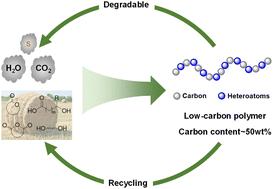制造低碳聚合物:可持续发展的选择
IF 9.2
1区 化学
Q1 CHEMISTRY, MULTIDISCIPLINARY
引用次数: 0
摘要
为了应对依赖石油和产生污染的一般聚合物材料所带来的挑战,我们提出用氧(或其他杂原子如硫)部分取代聚合物中的碳元素,并使用生物质碳构建低碳聚合物。天然纤维素的组成可以作为低碳聚合物的参考(O/C摩尔比为5/6,重量百分比为49.4%),通过分子设计创新,将非食用生物质原料、二氧化碳和工业碳/硫废物(即低碳单体)整合在一起,从而平衡性能/功能与降解/回收潜力。与传统的“富碳”聚合物相比,我们讨论了这些低碳聚合物的独特特性,并重点介绍了正在走向商业化的PLA、PHA和PPC的代表性例子。这一观点也解决了成本效益合成的关键挑战,开发新的催化剂/引发剂,以及结构-性能关系的调节,特别强调二氧化碳和生物质基聚合物的工业化。本文章由计算机程序翻译,如有差异,请以英文原文为准。

Making polymers with low carbon content: a sustainable option
To cope with the challenges posed by general polymer materials that rely on petroleum and generate pollution, we propose the partial substitution of carbon elements in polymers with oxygen (or other heteroatoms such as sulfur) and the use of biomass carbon to construct low-carbon polymers. The composition of natural cellulose can be used as a reference (O/C molar ratio of 5/6 and weight percentage of 49.4%) for low-carbon polymers that integrate non-edible biomass-based feedstocks, CO2, and industrial carbon/sulfur waste (i.e. low-carbon monomers) through molecular design innovations, thereby balancing the performance/function with degradation/recycling potential. We discuss the unique characteristics of these low-carbon polymers in comparison to conventional “carbon-rich” polymers, highlighting the representative examples of PLA, PHA and PPC that are on the way to commercialization. This perspective also addresses the critical challenges of cost-effective synthesis, developing new catalysts/initiators, and the regulation of structure–property relationship, with particular emphasis on the industrialization of CO2- and biomass-based polymers.
求助全文
通过发布文献求助,成功后即可免费获取论文全文。
去求助
来源期刊

Green Chemistry
化学-化学综合
CiteScore
16.10
自引率
7.10%
发文量
677
审稿时长
1.4 months
期刊介绍:
Green Chemistry is a journal that provides a unique forum for the publication of innovative research on the development of alternative green and sustainable technologies. The scope of Green Chemistry is based on the definition proposed by Anastas and Warner (Green Chemistry: Theory and Practice, P T Anastas and J C Warner, Oxford University Press, Oxford, 1998), which defines green chemistry as the utilisation of a set of principles that reduces or eliminates the use or generation of hazardous substances in the design, manufacture and application of chemical products. Green Chemistry aims to reduce the environmental impact of the chemical enterprise by developing a technology base that is inherently non-toxic to living things and the environment. The journal welcomes submissions on all aspects of research relating to this endeavor and publishes original and significant cutting-edge research that is likely to be of wide general appeal. For a work to be published, it must present a significant advance in green chemistry, including a comparison with existing methods and a demonstration of advantages over those methods.
 求助内容:
求助内容: 应助结果提醒方式:
应助结果提醒方式:


